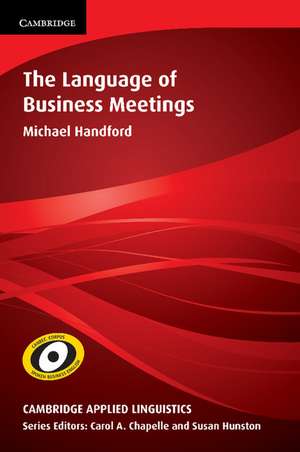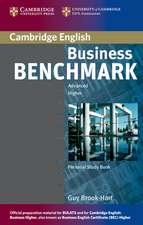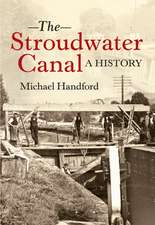The Language of Business Meetings
Autor Michael Handforden Limba Engleză Paperback – 18 aug 2010
Preț: 361.81 lei
Preț vechi: 393.27 lei
-8% Nou
Puncte Express: 543
Preț estimativ în valută:
69.25€ • 75.25$ • 58.21£
69.25€ • 75.25$ • 58.21£
Carte disponibilă
Livrare economică 31 martie-14 aprilie
Preluare comenzi: 021 569.72.76
Specificații
ISBN-13: 9780521133432
ISBN-10: 0521133432
Pagini: 286
Dimensiuni: 152 x 228 x 17 mm
Greutate: 0.46 kg
Editura: Cambridge University Press
Colecția Cambridge University Press
Locul publicării:Cambridge, United Kingdom
ISBN-10: 0521133432
Pagini: 286
Dimensiuni: 152 x 228 x 17 mm
Greutate: 0.46 kg
Editura: Cambridge University Press
Colecția Cambridge University Press
Locul publicării:Cambridge, United Kingdom
Cuprins
Series editors' preface; Acknowledgements; Transcription conventions; 1. CANBEC: corpus and context; 1.1. Data collection; 1.2. Corpus constituency; 1.3. Contextual information; 1.4. Transcription and anonymization; 1.5. Corpus size and generalizability; 1.6. Outline of the book; References; 2. Background: theory and methodology; 2.1. Theory; 2.2. Methodology; 2.3. Summary; References; 3. The business-meeting genre: stages and practices; 3.1. Applying Bhatia's multi-perspective model of discourse to business meetings; 3.2. The meeting matrix; 3.3. Applying the meeting matrix; 3.4. Summary; References; 4. Significant meeting words: keywords and concordances; 4.1. Institutional language and everyday English; 4.2. Lexico-grammatical theoretical considerations; 4.3. Word frequencies; 4.4. Keywords; 4.5. Summary; References; 5. Discourse marking and interaction: clusters and practices; 5.1. Defining clusters; 5.2. Clusters in business research; 5.3. Cluster lists; 5.4. Categorization of clusters; 5.5. Clusters in context; 5.6. Summary; References; 6. Interpersonal language: pronouns, backchannels, vague language, hedges and deontic modality; 6.1. The transactional/relational linguistic distinction; 6.2. Pronouns; 6.3. Backchannels; 6.4. Vague language; 6.5. Hedges; 6.6. Deontic modality; 6.7. Summary; References; 7. Interpersonal creativity: problem, issue, if, and metaphors and idioms; 7.1. Problem and issue; 7.2. If; 7.3. Metaphors and idioms; 7.4. Summary; References; 8. Turn-taking: power and constraint; 8.1. Turn-taking in internal meetings; 8.2. Turn-taking in external meetings; 8.3. Summary; References; 9. Teaching and learning implications; 9.1. Who is the learner?; 9.2. Teaching materials: what do they teach?; 9.3. How can a corpus such as CANBEC be exploited?; 9.4. Summary; References; Appendix; Index.
Descriere
This book presents a corpus-based study of the language used in business meetings.














